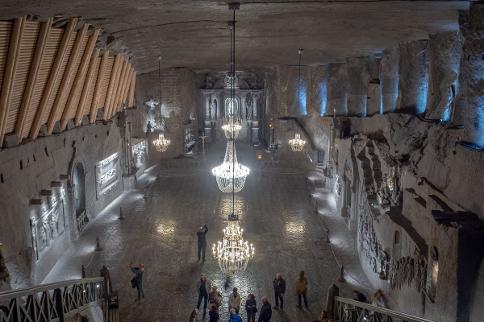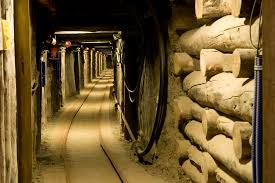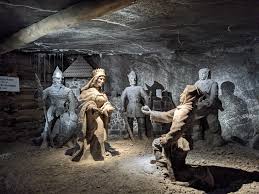How it began
A legend says that Kinga, a Hungarian princess about to be married to Bolesław V the Chaste, the Prince of Kraków.

However from more official sources we know that the first documentation of the mine dates from 1044, when duke Casimir I granted a privilege to a local monks collected to the salt around that time.We know more about the 13th century, when brine welling up to the surface had been collected and processed to aquiretable-salt. In this period, wells began to be sunk, and the first shafts to be dug to extract the rock salt. From the late 13th to the early 14th century, the Saltworks Castle was built.
For ages the salt has brought huge revenues to the Polish state. Even in 19th century, when Poland was partitioned, the mine was considered one of the most productive in the world.

Over the period of the mine's operation, many chambers were dug and various technologies were added, such as the Hungarian horse treadmill and the Saxon treadmill for hauling salt to the surface. By the late 1890s, machine drills and blasting were used to extract salt. During World War II, the mine was used by the occupying Germans as an underground facility for war-related manufacturing. Between August and October 1944, Jewish concentration camp prisoners were put to hard labour in the salt mines. Unfortunately, this is a forgotten aspect. There is also no memorial plaque commemorating these Jewish people.
Wieliczka Salt Mine routes
The mine stretches over 300 km (186 miles) of tunnels and goes down about 327 meters (1,073 feet). But don’t worry—tourist routes cover only a small (but stunning) part of it. 3.5-kilometre (2.2-mile) visitors' route (less than 2 percent of the mine passages' total length) including statues carved from the rock salt at various times. About 1.2 million people visit the Wieliczka Salt Mine annually.
If you decide to visit the salt mine, youwill find yourself in a good company. Notable visitors to this site have included Nicolaus Copernicus, Johann Wolfgang von Goethe, Alexander von Humboldt, Fryderyk Chopin, Dmitri Mendeleyev, Bolesław Prus, Ignacy Paderewski, Robert Baden-Powell, Jacob Bronowski (who filmed segments of The Ascent of Man in the mine), the von Unrug family (a prominent Polish-German royal family), Karol Wojtyła (later, Pope John Paul II), former U.S. President Bill Clinton, and many others.
The mine is sectioned into the Tourist Route and Museum Route.[26] The Tourist Route consists of the first 3 levels of the mine. It takes around 1.5 h to see the entire 2.2 kilometres long trail.
What you can see in Wieliczka Salt Mine
St. Kinga’s Chapel – a cathedral-sized chamber carved entirely from salt, including chandeliers! The St. Kinga Chapel and specific chambers are used for private functions, including weddings. A chamber has walls carved by miners to resemble wood, as in wooden churches built in early centuries.
Underground lakes - the most popular is Wessel Lake in Wessel Lake Chamber. The lake is filled with natural Wieliczka brine, thanks to which the air in the chamber contains large amounts of sodium chloride, calcium and magnesium. And for that reason the mine is actually an offcial health resort.
Salt sculptures made by miners - that's what they do after work... at least some of them .

A subterranean museum - It is the largest underground museum in Europe (with a surface area of 7,481 m2). It is the largest underground museum in Europe (with a surface area of 7,481 m2).
he Museum presents the only collection of former wooden extraction machines in the world, predecessors of steam and electric machines. Apart from this, the Museum was provided with archives and the Saltworks library as well as a precious collection of mining maps.
Vibe Check
Yes, it’s atmospheric - dimly lit tunnels, echoey chambers, and walls you can literally lick (yes, they’re salty). There’s also a sense of reverence, especially in the chapels.
Visiting Tips
Tours are guided only, and available in multiple languages.
It stays a cool 14°C (57°F) year-round, so bring a jacket.
There are over 800 steps, with a lot of descending, but there’s an elevator to get you back up.
If you're claustrophobic, just a heads-up—some areas are quite narrow.
An elevator (lift) returns visitors to the surface; the elevator holds 36 persons (nine per car) and takes about 30 seconds to make the trip.
To get to the salt mine on bus number 304 from Dworzec Główny Zachód stop, near Krakow city center. Stop to go to the Daniłowicz Shaft entrance or get off at the Wieliczka Rynek stop to go to the Regis Shaft entrance.
For more info about travel and to buy tickets to the mine go here: